
Armchair historians will recall the beginning of WWII in 1939, where Germany, Britain, and France had declared war against each other, but no shots were fired for eight months.
It was called the Phony War. It ended when Germany invaded Belgium, and then France.
We have a Phony War of our own in the markets these days, being fought tooth and nail around the S&P 500 50-day moving average. Every assault is repulsed, every false breakout followed by a retreat.
Hyper bulls believe an upside breakout is imminent. Bears think we have to go back and retest the lows before proceeding. I am in the latter camp, but only see a weak retest at worst.
Volatility spikes are like cockroaches. There is never just one.
There is just too much money out there trying to get in. And now that earnings season is over, so is the "quiet period" and companies have free reign with which to buy back their own shares.
With tax cuts and repatriation, they now have more money than ever with which to buy back their own shares, and they are doing so with both hands.
We have a Phony War of another sort, that against stocks. The 13.3% intraday top to bottom move we saw in the Dow Average was totally bogus, as I expected.
The net result of all this is to leave the major stock indexes unchanged on the year. A zero return for two months of work! I heard wages were falling, but not that fast!
This month has been a harsh lesson in the uselessness of technical analysis. Not only did it fail to predict a top, it also missed the bottom by miles. If anything, technical services were urging you to sell at the bottom, as they always do.
Those like me who use fundamental research to drive decisions KNEW that share prices made no sense with a Dow at 23,000 given the robust state of the economy, especially technology ones.
That gave me, and therefore you, the confidence to load the boat with technology stocks at the bottom, to great effect.
It has been another eye-popping performance this week.
We saw the first failure of a US Treasury bond auction in yonks. The Treasury attempted to unload $258 billion in paper last week and there were few takers.
Foreign investors, who normally take half of Uncle Sam's bond issues, were virtually absent. The two-year Treasury bill saw a yield of 2.25%, a ten-year high.
It turns out that using tax cuts to starve government revenues, while dramatically increasing spending to achieve political goals, isn't such a great thing for bond owners.
As for me, I have covered the last of a dozen short positions in bonds that I have strapped on over the past seven months. Things were getting just too good. During this time, the ten-year US Treasury bond yield leapt from 2.03% to a 2.95% high on Thursday.
That's an increase of 45.32%. What happens when yields rise another 45.32%, and another 45.32% after that? What will be the impact on stock prices? I fear no good, not good.
This is what all stock traders and investors have in the back of their minds these days, if not the front.
I wish there was such a thing as a Cassandra Index. The more talking heads and newsletters decrying the end of the world, as we saw in droves on February 9, the better the risk reward for investing.
The Volatility Index (VIX) used to perform such a service, but it does no longer, overtaken by algos and extreme leverage.
So, why are the FANGS really going up? I bet you'd like to know, since if you have been following the Diary of a Mad Hedge Fund Trader you already have them coming out of your ears.
Not only have they outperformed every asset class by miles over the past two years. They bounced back like silly putty in the wake of the recent crash, some already to new all-time highs.
The concentration of the rally has been breathtaking. Some 48% of the rise in the S&P 500 this year has been accounted for by just three stocks; Amazon (AMZN) (27%), (Microsoft (MSFT) (13%), and Netflix (NFLX) (8%).
How about this theory? Technology is virtually the only sector of the economy that does NOT borrow money. Their profits and cash flows are so enormous that they can generate any money they need to finance future growth internally.
When they do borrow, such as seen with Apple's recent 30-year bond issue, it is really only to engage in financial engineering. Borrowing at 2% to buy 2% yielding stock back when your compensation is tied to stock performance?
How hard is that to figure out?
This coming week will be dominated by raft of new housing data, followed by an updated read on Q1 GDP.
On Monday, February 26 at 10:00 AM EST we kick off the week with February New Homes Sales.
On Tuesday, February 27 at 8:30 AM we learn February Durable Goods Orders. The S&P Corelogic Case Shiller Home Price Index is out at 9:00 AM EST, a three-month lagging indicator of residential real estate prices.
On Wednesday, February 28, at 8:30 AM EST, we get another read on Q1 GDP. February Pending Home Sales follow at 10:00 AM.
Thursday, March 1 leads with the Weekly Jobless Claims at 8:30 AM EST. The PMI Manufacturing Index comes next at 9:45 AM EST.
On Friday, March 2 at 1:00 PM we receive the Baker-Hughes Rig Count, which saw a small rise of three last week.
As for me, I shall spend the weekend pouring over reports from my technology, looking for the best place to strike during the next selloff.
What I am learning from my own Mad Hedge Technology Letter, which by the way has a perfect track record since inception, is nothing less than amazing.
Good luck and good trading!
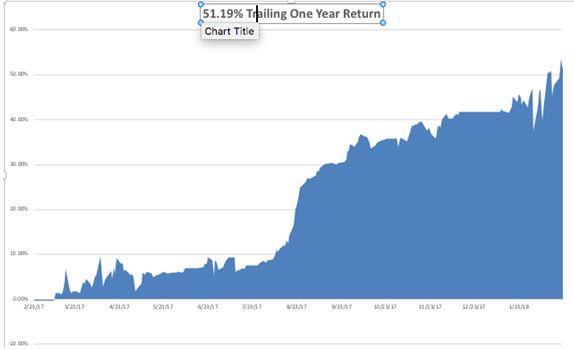
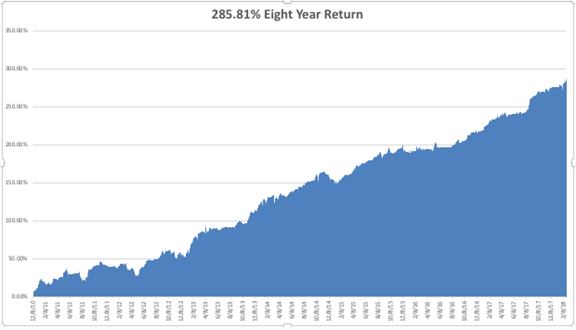
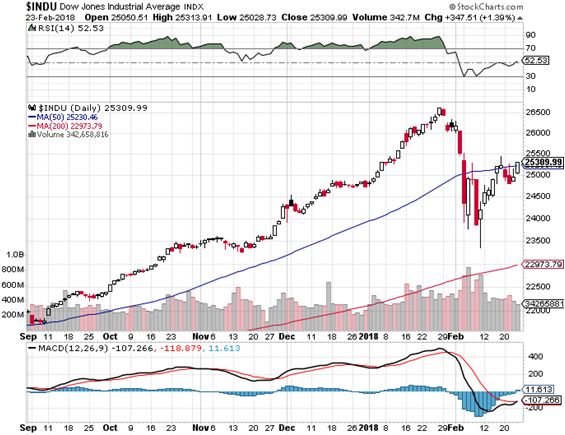
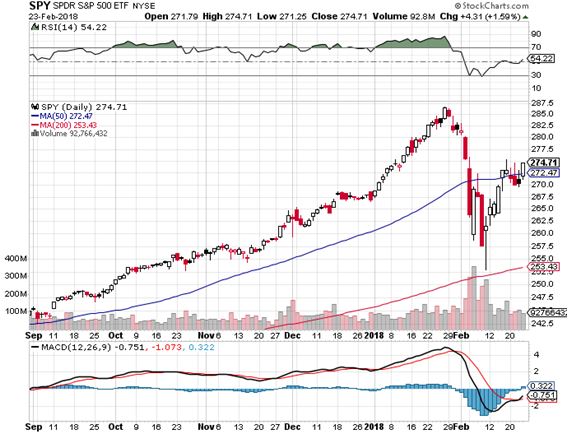
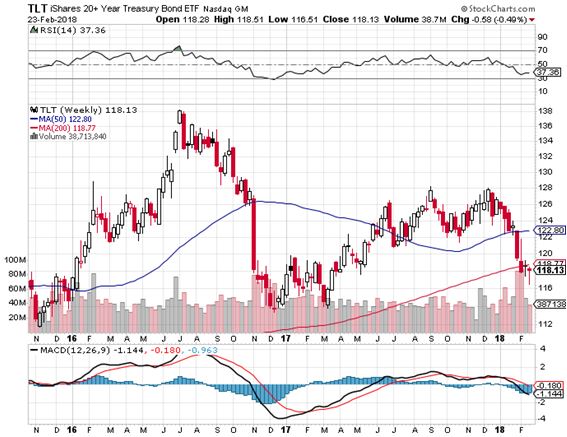

I Occasionally Have Been Known to Toot My Own Horn
Global Market Comments
February 23, 2018
Fiat Lux
Featured Trade:
(FEBRUARY 28 GLOBAL STRATEGY WEBINAR),
(AMERICA'S DEMOGRAPHIC TIME BOMB),
(EEM), (CYB),
(ON EXECUTING TRADE ALERTS),
(SCAM OF THE MONTH CLUB)
Global Market Comments
February 22, 2018
Fiat Lux
Featured Trade:
(WHO WILL BE THE NEXT FANG?)
(FB), (AMZN), (NFLX), (GOOGL), (AAPL),
(BABA), (TSLA), (WMT), (MSFT),
(IBM), (VZ), (T), (CMCSA), (TWX)
Global Market Comments
February 21, 2018
Fiat Lux
SPECIAL FANG ISSUE
Featured Trade:
(FINDING A NEW FANG),
(FB), (AAPL), (NFLX), (GOOGL),
(TSLA), (BABA)
Global Market Comments
February 20, 2018
Fiat Lux
Featured Trade:
(MARKET OUTLOOK FOR THE WEEK AHEAD, or GOING WHERE THE MONEY IS),
(SPY), (AAPL), (MU), (FB), (CRM), (AMZN), (T),
(THE REBIRTH OF THE MASTER LIMITED PARTNERSHIP),
(USO), (AMLP), (FPL), (MLPS), (MLPX)
Things have changed.
That is about the only conclusion one can reach after the three most violent weeks in stock market history.
The historic average length of time for a 10% correction is 64 days, or more than two months. This time we did it in nine.
However, we all learned important things from the experience.
For a start, if your financial advisor told you to sell all your stocks at the bottom fire them immediately. A lot did, because we could see it in the February 9 capitulation market volume. Selling lows and buying highs is certainly NOT the way to financial freedom and independence.
Also, we learned the value of the 200-day moving average. A whole bunch of Fibonacci support numbers kicked in right about the same place.
I have never been big on technical analysis, viewing it as the refuge of newbies and wanabees who can't figure out what else to do. They are the red meat for the algos.
However, I could see the S&P 500 (SPY) gunning for this number at $252, and sent you trade alerts to BUY as fast as I could write them as we approached it. But the 2,000 Dow rally that followed? That was the stuff of B-movies.
I was also willing to bet the ranch that technology would lead any recovery. This is the sector that every investor, from the day trading college student to the $100 billion hedge fund manager has been trying to get into at a decent price for years.
And tech delivered big time. It has been the most instant creation of market wealth in history, with my names of Apple (AAPL), Micron Technology (MU), Facebook (FB), Salesforce (CRM), and Amazon (AMZN) leading the charge.
And then to short the Volatility Index (VIX) at $39 and watch it halve in days? It boggles the mind.
Probably the smartest thing I have done in my 50-year trading career was to start the Mad Hedge Technology Letter on February 1.
The insights I am gaining with the additional research has not only substantially upped my game in technology, but all other asset classes as well. They're all connected.
Why technology, when more attractive opportunities beckoned with gold or Bitcoin newsletters?
To quote the famed bank robber, Willie Sutton, as to why he robbed banks, "It's where the money is."
By the way, you can still buy the Mad Hedge Technology Letter
at the inaugural price of only $2,000. The full $2,500 price kicks in on March 1. To learned more please click here. To get the discount price please email Nancy at customer support at support@madhedgefundtrader.com
One amazing concept that I have just stumbled across is that big tech has become the new defensive "safe play", replacing the high yield telecom stocks of old, like AT&T (T).
Apple is already the largest dividend payer in the United States in absolute dollar terms. It is returning a stunning 90% of its gargantuan free cash flow to shareholders, with some 72% going to share buybacks alone.
After a 17-year hiatus, Apple resumed its dividend five years ago (Steve Jobs hated the idea), and now stands at a 1.46% yield. The company has since boosted its dividend by 10% every April like clockwork.
We here at Mad Hedge Fund Trader made a heroic effort to help followers of our Trade Alert service cope with the most tumultuous market in history.
At the worst of the worst we were down only -8%, and fought tooth and nail to get back up to +5.5% by Friday. It was a performance for the ages. It is also a vindication of the trading strategy I have been pursuing for the last decade.
If you can survive this week, you can survive anything. You are totally bombproof.
We only got nicked at the end with a short position in Apple which we picked up two days too soon. But then how often does the world's largest company rise in value by 12% in four days, adding $125 billion in market capitalization?
How about once a lifetime.
We are now done with Q4 earnings season, so the dominant factor will be the Fed governors who will be speaking at public appearances every day of this shortened week. No doubt inflation will be a hot topic, a definite market negative.
On Monday, February 19, the markets were closed for Presidents Day.
On Tuesday, February 20 no data releases of note take place.
On Wednesday, February 21, at 10:00 AM EST, we get January Existing Home Sales. The FOMC minutes of the last Fed meeting on interest rates will be released at 2:00 PM.
Thursday, February 22 leads with the 10:00 EST release of the Index of Leading Economic Indicators, a read on ten data points giving a read on economic performance six months into the future.
On Friday, February 23 at 1:00 PM we receive the Baker-Hughes Rig Count, which saw no change last week.
As for me, I am trying to get rid of the tag ends of pneumonia I have been dealing with for the past month, the result of my January battle with the flu.
I think I'll head over to Squaw Valley and dive down a couple of double black diamond slopes. I hear that exercise helps clear the lungs.
Good luck and good trading!
Global Market Comments
February 16, 2018
Fiat Lux
Featured Trade:
(FEBRUARY 14 GLOBAL STRATEGY WEBINAR Q&A),
(VIX), (VXX), (FCX), (BAC), (GS), (JPM), (HEDJ), (SPG), (HEDJ),
(IT???S TIME TO PULL THOSE OLD INFLATION PLAYS OUT OF THE DRAWER),
(TIP), (TIPZ), (TIPX), (GLD), (SLV)
Q: How much more will interest rates rise and how will that affect equities?
A: We've essentially discounted all the negative effects of rising interest rates for the rest of the year with this correction, so I don't believe we'll have much interest rate impact from here. I'm looking for 3.25% on the 10 year by the end of this year - that's 10 1/2 months, so we're basically almost there.
In regard to how it will affect equities: It won't. We basically digested 150 basis points of interest rate rise ALREADY. Now, if we get another hot CPI in a month, all bets are off. Then the sushi will really hit the fan.
Q: Which sector will lead after this meltdown?
A: Technology, technology, technology. That's why I started a technology letter at the beginning of the month. I want to focus everyone's attention on the technology letter. It will overwhelmingly lead, not only this year, but for the next 20 years.
Q: Has the Volatility Index Bottomed?
A: Absolutely. We'll never see the $9 number again. We're now looking to find a new volatility range. Currently we are at a (VXX) of $41.65 and a (VIX) of $19.61. I expect we'll find a range-maybe $15-$25-?and we'll trade in that range for the rest of the year. With the entire short VIX industry wiped out you will never again return to those old low ranges.
Q: With volatility so high right now, is it better to buy naked calls instead of call spreads?
A: No it is not. Assume your range will be $15-$25 in the (VIX) you want to be buying the put spread at the top and the call spreads at the bottom; that way you don't get wiped out with time decay. If you go outright naked long calls or puts the time decay in these things will absolutely destroy you.
Q: Does this market shake-up change your end of year targets for the S&P 500?
A: The answer is yes. I know I upgraded them to a 20% increase this year. My original, beginning January forecast was for 10% correction, which we got, then a 20% rally to be up 10% on the year. That's a much more realistic forecast than the upgrade that followed. So yes, it does change. I'm still looking for 10% by the end of the year -we're essentially at 0% right now. We gave up all of the year's gains, and at the bottom we went all the way back to October/November prices.
Q: Will wage increases and higher inflation bring down companies who have high labor costs?
A: Yes, they will. Who are the highest labor cost companies in the United States? Walmart (WMT), Target (TBT) and McDonald's (MCD). And that may be why those share prices have recently been acting so poorly.
Q: Will housing stocks like Lennar (LEN) get crushed with the new interest rate narratives?
A: They've already been crushed, which you can see on the housing charts we'll be looking at. However, I expect them to recover; interest rates are rising but not enough yet to hurt the housing market. It will be a year or two before they get to that point.
Q: Which is better: Bank of America (BAC), Goldman Sachs (GS), or J.P. Morgan (JPM)?
A: J.P. Morgan is the better-quality company, but that is already discounted in the price. If you want to buy a laggard, I recommend Goldman Sachs, which should be making significant profits trading in these conditions and is much cheaper. Goldman can double from here, whereas (BAC) and (JPM) may only increase 50%. J.P. Morgan also held up at the 50-day, which is incredibly encouraging; that's a buy right here, right now. No need to wait for a dip on J.P. Morgan. If I had the funds, I'd be buying myself.
Q: Should I sell the (AEX)? (a Europe-wide ETF traded in Holland)
A: No. If the U.S. rallies to new all-time highs over the next several months, which it will, Europe will do exactly the same, but probably rise twice as much. So, if anything, I would be a buyer of Europe at these levels, including the (HEDJ), which hedges out your Euro currency risk.
Q: I still own the Apple 140/145's. Thoughts?
A: Keep them. I think there is just 0% chance Apple will ever return to $150 a share, at least not until the next real recession, which is 2 years off.
Q: Is it acceptable to enter a Trade Alert a few days after it was originally issued, if I can get the same price?
A: Yes. If you can get that Trade Alert at a good price- and often, you can- then take it.
Q: If the market can absorb interest rates grinding higher, what is the next red flag that will take the market down?
A: Even higher interest rates.
Q: Microsoft's (MSFT) cloud business grew 100% YOY- would you look at getting into these levels?
A: I would. In fact, if I could take an 11th position, it would be a long in Microsoft at these levels.
Q: Which part of the stock market should I avoid if interest rates are rising?
A: You want to avoid heavy borrowers; those include REITS (SPG) and Utility Stocks (XLU).
Q: Are commodities a buy since you have been telling us to stay away for years?
A: While the stock market may be going crazy, the global synchronized economic recovery continues, and that is a very pro-commodity move- when people move out of expensive stocks, what do they buy? Cheap commodities. Which have been in a 5-year bear market.
Q: How will the new Fed Governor Jerome Powell change from Yellen once he saw the huge sell-off on the first day of the job?
A: He won't change but he will be facing different challenges than Yellen did: the need to raise interest rates faster. Yellen was all about keeping interest rates low for as long as possible- that is now ancient history. It's all about how fast we raise rates from now on that impacts the market.
Q: Is it ok to keep my Freeport-McMoRan (FCX)?
A: Yes, it will rally back strong and this is a good entry point. Historically, going into silver is better than gold. Historically that has been true, but it's not happening this time. I would stay away.
Q: What do you think about commodities this year?
A: They will outperform stocks.
Global Market Comments
February 15, 2018
Fiat Lux
Featured Trade:
(THE NEW CASE FOR EUROPE),
(FXE), (DXJ), (RSX), (FXE), (EUO),
(WHY ARE BOND YIELDS STILL SO LOW?),
(TLT), (TBT), (JNK), (LQD), (MUB)
It is time to revisit this once troubled continent. The reality is that the European economy is now growing substantially faster than the US, with a better stock market performance to match.
Not only that, the Euro has been rising, thanks to America’s exploding budget deficits.
Rising markets and rising currencies create an upward hockey stick effect on your profits.
I bet you didn’t know that the Greek stock market rose over 40% from November, and the Euro (FXE) added another 7%!
I have been to Greece many times over the past 50 years, and I’ll tell you that I just love the place.
The beaches are perfect, the Ouzo wine enticing, and I’ll never say “No” to a good moussaka.
As for the old Youth Hostel in Athens with the permanently clogged sewer lines, I now much prefer the five star King George Hotel.
However, I don’t let Greece dictate my investment strategy.
Greece, in fact, accounts for less than 2% of Europe’s GDP.
It is not a storm in a teacup that is going on there, but a storm in a thimble.
Greece is really just a full employment contract for financial journalists, who like to throw around big words like bankruptcy, default, and contagion.
I have other things to worry about.
In fact, I am starting to come around to the belief that Europe is looking pretty good right here, refugee crisis, Brexit, and trade wars be damned!
That’s why the better hedge funds have been piling in there since the presidential election. In fact, many managers prefer foreign developed stock market than the domestic US variety.
Fiat CEO, Sergio Marchionne, the brilliant personal savior of Chrysler during the crash, thinks the beleaguered continent is about to recover from “hell” to only “purgatory.”
Only a devout Catholic could come up with such a characterization.
But I love Sergio nevertheless because he generously helps me with my Italian pronunciation when we speak (“aspirapolvere” means “vacuum cleaner”, really?).
Notice that these European based equity ETF’s vastly outperform those for the main US indexes during the same time by a large margin, many by 2:1.
And here is where I come in with my own 30,000-foot view.
The undisputed lesson of the past nine years is that you always want to own stock markets that are about to receive an overdose of quantitative easing.
Since the US Federal Reserve launched their aggressive monetary policy, the S&P 500 (SPY) has nearly quadrupled off the bottom.
Europe was a late entrant to the QE game, and it could run for at least six more months.
Corporations across the pond are being force-fed mountains of cash at recently neagative interest rates, much like a goose being fattened for a fine dish of foie gras (only decriminalized in California last year).
Get Europe off the mat, and you can also add another 10% to US share prices as well, as the global economy revives.
Buy the Wisdom Tree International Hedged Equity Fund ETF (HEDJ) down here on dips, which is long a basket of European stocks and short the Euro (FXE). The recent correction just gave us a nice fat entry point.
These could be the big performers this year.
Praise the Lord and pass the foie gras!



















